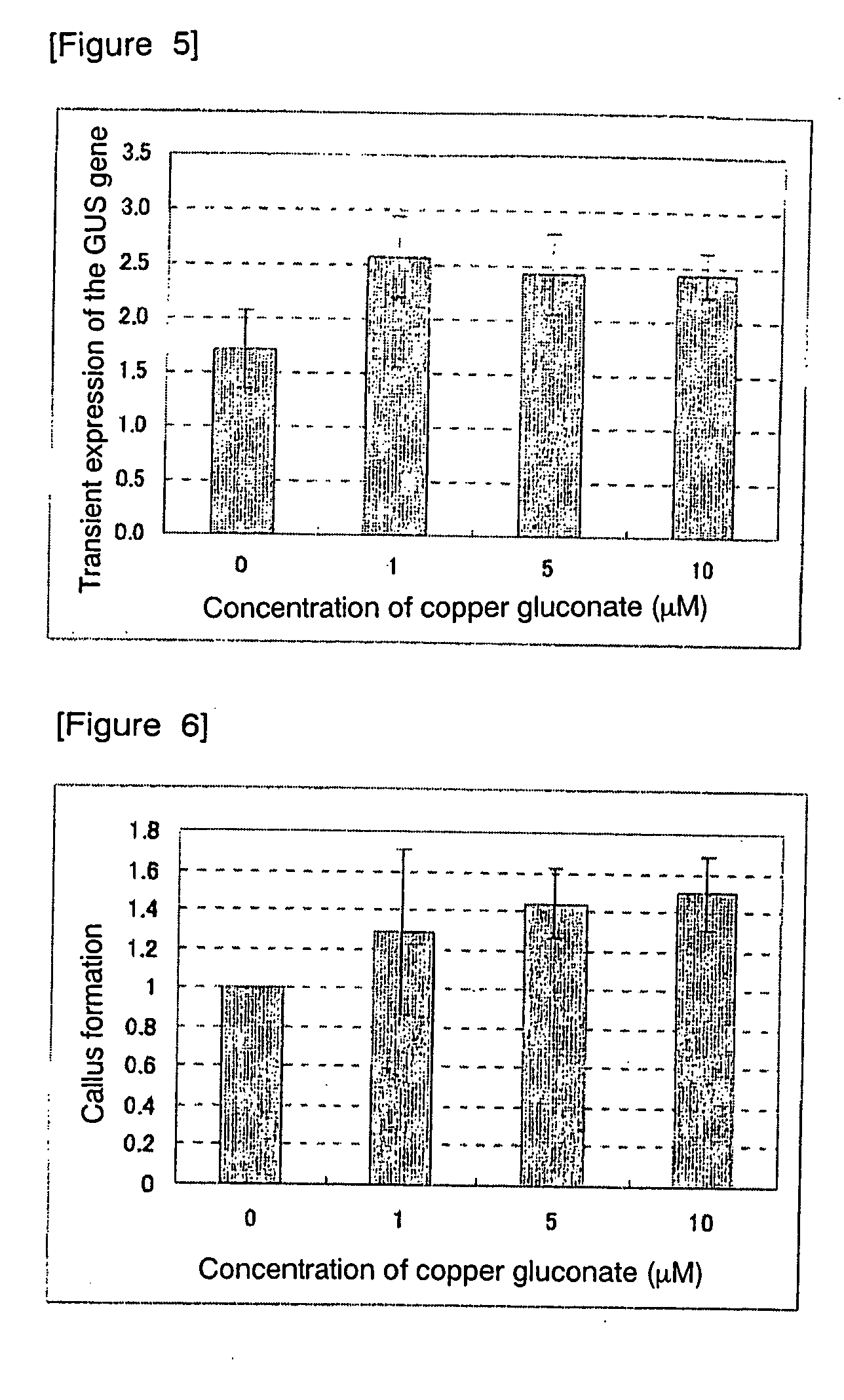Method for improving plant transformation efficiency by adding copper ion
a technology of agrobacterium and ion, applied in the field of efficient method of agrobacterium-mediated gene introduction, can solve the problems of low i>agrobacterium/i>-mediated transformation efficiency, large variation in and disadvantages of plants, so as to improve the efficiency of gene introduction and/or transformation efficiency, promote the growth of regenerated plants, and improve the effect of gene introduction efficiency
- Summary
- Abstract
- Description
- Claims
- Application Information
AI Technical Summary
Benefits of technology
Problems solved by technology
Method used
Image
Examples
example 1
Effects of Adding Copper Sulfate to Co-culture Media on Maize Transformation
Materials and Methods
[0117] Immature embryos (size: 1.0-1.5 mm) of maize (cultivars: A188, H99) at days 7-14 post-pollination were aseptically collected and washed once in LS-inf liquid medium (LS salts, 0.5 mg / l nicotinic acid, 0.5 mg / l pyridoxine hydrochloride, 1 mg / l thiamine hydrochloride, 100 mg / l myoinositol, 1 g / l casamino acids, 1.5 mg / l 2,4-D, 68.5 g / l sucrose, 36 g / l glucose, pH 5.2; see Ishida, Y., et al., (1996), Nature Biotechnology, Vol.4, p.745-750). The immature embryos were partially pretreated for increasing the gene transduction efficiency (heated at 46° C. for 3 minutes and centrifuged at 15,000 rpm for 10 minutes). Agrobacterium tumefaciens LBA4404 (pSB131) (carrying a PPT (phosphinothricin) resistance gene driven by the cauliflower mosaic virus 35S promoter and the GUS gene containing a castor bean catalase intron fused to the cauliflower mosaic virus 35S promoter in the T-DNA region...
example 2
Effects of Adding Copper Sulfate to Co-culture Media on Gene Introduction of Rice
Materials and Methods
[0126] An Agrobacterium tumefaciens super-binary vector designated LBA4404 (pSB134) (carrying the HPT gene (hygromycin resistance gene) fused to a ubiquitin intron driven by a maize ubiquitin promoter and the GUS gene fused to a castor bean catalase intron driven by the cauliflower mosaic virus 35S promoter in the T-DNA region; construction of pSB134 was performed by inserting a 35S-intron GUS-nos fragment derived from pSB32 as an expression marker into HindIII of pKY205 (see WO 03 / 027290)) cultured on AB medium (3 g / l KH2PO4, 1 g / l NaH2PO4, 1 g / l NH4Cl, 300 mg / l MgSO4. 7H2O, 150 mg / l KCl, 10 mg / l CaCl2, 2.5 mg / l FeSO4.7H2O, 5 g / l glucose, 15 g / l agar, pH 7.0; Chilton, M.-D., et al., (1974), Proc. Natl. Acad. Sci. U.S.A., 71:3672-3676) containing 50 mg / l hygromycin and 50 mg / l spectinomycin for 3 to 4 days was scraped with a platinum loop and suspended at a concentration of about...
example 3
Effects of Adding Copper Gluconate to Co-culture Media on Gene Introduction of Maize
Materials and Methods
[0130] Immature embryos (size: 1.0-1.5 mm) of maize (cultivar: A188) at days 7-14 post-pollination were aseptically collected and washed once in LS-inf liquid medium. A pretreatment for increasing gene transduction efficiency (heating at 46° C. for 3 minutes and centrifugation at 15,000 rpm for 10 minutes) was performed. Agrobacterium tumefaciens LBA4404 (pSB131) was suspended at about 1.0×109 cfu / ml in LS-inf liquid medium containing 100 μM acetosyringone to prepare an inoculum. The inoculum was added to the heated / centrifuged immature embryos, and the suspension was agitated for 30 seconds and then allowed to stand for 5 minutes at room temperature. The Agrobacterium-inoculated immature embryos were plated on co-culture media containing copper gluconate at a concentration of 0-10 μM in LS-AS medium containing 5 μM AgNO3 with the scutellum facing upward.
[0131] The immature e...
PUM
| Property | Measurement | Unit |
|---|---|---|
| concentration | aaaaa | aaaaa |
| concentration | aaaaa | aaaaa |
| Ri | aaaaa | aaaaa |
Abstract
Description
Claims
Application Information
 Login to View More
Login to View More - R&D
- Intellectual Property
- Life Sciences
- Materials
- Tech Scout
- Unparalleled Data Quality
- Higher Quality Content
- 60% Fewer Hallucinations
Browse by: Latest US Patents, China's latest patents, Technical Efficacy Thesaurus, Application Domain, Technology Topic, Popular Technical Reports.
© 2025 PatSnap. All rights reserved.Legal|Privacy policy|Modern Slavery Act Transparency Statement|Sitemap|About US| Contact US: help@patsnap.com



